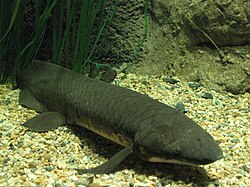Queensland lungfish
species of fish (Neoceratodus forsteri) From Wikipedia, the free encyclopedia
The Queensland lungfish (Neoceratodus forsteri), also known as the Australian lungfish, Burnett salmon and barramunda, is one of the surviving species of lungfish. It is native only to the Mary and Burnett River systems of the Australian state of Queensland. The species has been introduced elsewhere and is also found in many other parts of Queensland's south-east. Although it is not a threatened species, the Queensland lungfish are protected.[7]
| Queensland lungfish | |
|---|---|
 | |
| National Zoo & Aquarium, Australia | |
| Scientific classification | |
| Domain: | Eukaryota |
| Kingdom: | Animalia |
| Phylum: | Chordata |
| Class: | Dipnoi |
| Order: | Ceratodontiformes |
| Family: | Neoceratodontidae |
| Genus: | Neoceratodus |
| Species: | N. forsteri |
| Binomial name | |
| Neoceratodus forsteri (J. L. G. Krefft, 1870) | |
| Synonyms[4][5][6] | |
| |
Fossils of Queensland lungfish from up to 380 million years ago have been discovered. The species lives in slow-flowing rivers and still water (including reservoirs). They are commonly found to be about 100 cm (3.3 ft) in length and weigh 20 kg (44 lb), but can get up to 150 cm (4.9 ft) in length and weigh 43 kg (95 lb).[8]
References
Other websites
Wikiwand - on
Seamless Wikipedia browsing. On steroids.

